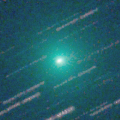
|
Now it is very bright as 7.1 mag (Nov. 26, Willian Souza). It will approach to Sun down to 0.4 a.u. on Dec. 13, and will brighten up to 6 mag. It will be unobservable soon.
Date(TT) R.A. (2000) Decl. Delta r Elong. m1 Best Time(A, h)
Nov. 28 14 3.44 -22 50.0 1.081 0.555 30 6.6 2:57 (294, 6)
Dec. 5 15 10.15 -23 39.1 1.165 0.449 22 5.9 2:54 (300, -1)
|
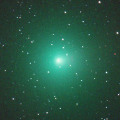
|
Now it is very bright as 7.8 mag (Nov. 24, Marco Goiato). In the Northern Hemisphere, it stays observable in excellent condition for a long time. In the Southern Hemisphere, it will be low in December.
Date(TT) R.A. (2000) Decl. Delta r Elong. m1 Best Time(A, h)
Nov. 28 5 25.80 21 58.9 0.386 1.361 163 8.0 0:59 (180, 33)
Dec. 5 5 23.04 29 34.7 0.421 1.401 169 8.4 0:28 (180, 26)
|
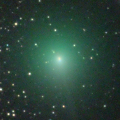
|
Now it is 9.4 mag (Nov. 15, Chris Wyatt). It stays observable in the evening low sky after this while it will be getting fainter gradually.
Date(TT) R.A. (2000) Decl. Delta r Elong. m1 Best Time(A, h)
Nov. 28 20 29.55 -22 46.6 1.780 1.515 58 10.1 20:39 ( 81, 29)
Dec. 5 20 53.26 -21 11.1 1.849 1.549 56 10.3 20:47 ( 82, 26)
|
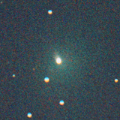
|
Brightened rapidly. Now it is very bright as 9.7 mag (Nov. 15, Chris Wyatt). It is observable at 10-11 mag in excellent condition from October to November.
Date(TT) R.A. (2000) Decl. Delta r Elong. m1 Best Time(A, h)
Nov. 28 23 58.45 6 24.2 0.569 1.338 116 10.5 20:39 (155, 45)
Dec. 5 0 10.43 11 19.9 0.606 1.348 113 11.0 20:47 (150, 38)
|
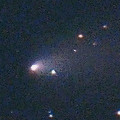
|
First return of a new periodic comet which brightened up to 13 mag in 2009. Now it is bright as 13.5 mag (Nov. 21, Seiichi Yoshida). It is expected to brighten up to 12 mag and to be observable in excellent condition in winter.
Date(TT) R.A. (2000) Decl. Delta r Elong. m1 Best Time(A, h)
Nov. 28 4 23.33 -12 52.9 0.411 1.346 145 12.7 23:52 (180, 68)
Dec. 5 4 25.95 -11 45.2 0.394 1.329 145 12.5 23:27 (180, 67)
|

|
It brightened up to 13.5 mag in summer (July 31, Ken-ichi Kadota). It is expected to brighten up to 12 mag from autumn to winter. In the Southern Hemisphere, it will appear in the morning sky in December, then it stays observable in good condition. In the Northern Hemisphere, it will be observable in the extremely low sky only from November to December.
Date(TT) R.A. (2000) Decl. Delta r Elong. m1 Best Time(A, h)
Nov. 28 13 54.00 -19 49.8 2.442 1.705 33 12.6 2:57 (290, 6)
Dec. 5 14 1.15 -23 59.1 2.372 1.705 37 12.5 2:54 (291, 11)
|
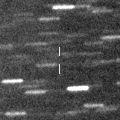
|
It was expected to brighten very rapidly, and brighten up to 11 mag from December to January. But actually it is much fainter than this ephemeris. Now it is fainter than 16.5 mag (Nov. 21, Michael Jager). It stays observable for a long time in this apparition.
Date(TT) R.A. (2000) Decl. Delta r Elong. m1 Best Time(A, h)
Nov. 28 19 51.13 -10 11.5 0.954 0.861 52 13.2 20:39 ( 88, 15)
Dec. 5 20 19.48 -9 52.1 0.879 0.829 52 12.6 20:47 ( 87, 13)
|

|
It will approach to Sun down to 0.14 a.u. on Dec. 7, and will brighten up to 11 mag. But it is not observable at the high light.
Date(TT) R.A. (2000) Decl. Delta r Elong. m1 Best Time(A, h)
Nov. 28 14 43.76 -21 37.6 0.801 0.380 21 15.8 2:57 (298, -2)
Dec. 5 16 3.95 -24 36.6 1.021 0.178 9 13.2 2:54 (309, -9)
|
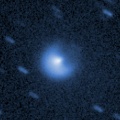
|
Jean-Franois Soulier and Nick James discovered its new outburst on Nov. 19. Now it is bright as 12.6 mag (Nov. 20, Maik Meyer).
Date(TT) R.A. (2000) Decl. Delta r Elong. m1 Best Time(A, h)
Nov. 28 2 21.94 25 50.4 4.940 5.840 153 13.2 21:51 (180, 29)
Dec. 5 2 19.39 25 30.3 4.995 5.841 146 13.2 21:21 (180, 29)
|
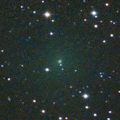
|
It approached to Earth down to 0.5 a.u. in November, and it brightened very rapidly. Now it is very bright as 13.4 mag (Nov. 6, Michael Jager). It is observable in excellent condition. But it seems to fade out very rapidly after this.
Date(TT) R.A. (2000) Decl. Delta r Elong. m1 Best Time(A, h)
Nov. 28 0 44.37 12 14.3 0.539 1.389 128 13.6 20:39 (172, 42)
Dec. 5 1 2.47 10 16.3 0.567 1.392 125 13.8 20:47 (166, 44)
|

|
Now it is 11.2 mag (Sept. 11, Carlos Labordena). Now it is not observable. It will appear in the morning sky at 14.5 mag.
Date(TT) R.A. (2000) Decl. Delta r Elong. m1 Best Time(A, h)
Nov. 28 16 10.92 -20 55.5 4.044 3.058 1 13.8 2:57 (313,-18)
Dec. 5 16 19.72 -22 7.9 4.103 3.125 6 13.9 2:54 (311,-14)
|
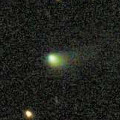
|
It stays 13-14 mag from 2020 to 2021. It is not observable until January.
Date(TT) R.A. (2000) Decl. Delta r Elong. m1 Best Time(A, h)
Nov. 28 15 49.50 -15 12.9 3.873 2.902 8 14.4 2:57 (305,-18)
Dec. 5 16 1.15 -16 5.9 3.851 2.897 12 14.4 2:54 (303,-16)
|
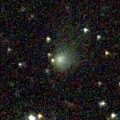
|
Now it is 14.0 mag (Nov. 11, Toshihiko Ikemura, Hirohisa Sato). It is expected to be observable at 5-6 mag for a long time from 2022 to 2023. In the Northern Hemisphere, it is not observable at the high light from 2022 summer to 2023 summer. In the Southern Hemisphere, it is not observable now. But it will be observable in good condition at the high light.
Date(TT) R.A. (2000) Decl. Delta r Elong. m1 Best Time(A, h)
Nov. 28 17 31.92 36 34.6 8.138 7.701 60 14.4 20:39 (112,-38)
Dec. 5 17 36.07 36 7.7 8.098 7.647 59 14.4 20:47 (109,-44)
|
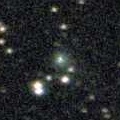
|
Now it is 13.9 mag (Nov. 9, Toshihiko Ikemura, Hirohisa Sato). It will brighten up to 12 mag in winter in 2022. In the Northern Hemisphere, it stays observable in good condition for a long time. In the Southern Hemisphere, it is not observable until 2021 November.
Date(TT) R.A. (2000) Decl. Delta r Elong. m1 Best Time(A, h)
Nov. 28 23 54.55 61 32.5 4.483 5.053 120 14.5 20:39 (171, -8)
Dec. 5 23 55.66 60 35.6 4.475 5.012 117 14.5 20:47 (167, -8)
|
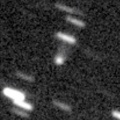
|
Now it is 14.8 mag (May 14, Toshiyuki Takahashi). It will brighten up to 13 mag in 2021. In the Southern Hemisphere, it becomes too low to observe temporarily from mid October to mid December. In the Northern Hemisphere, it is not observable until July in 2022.
Date(TT) R.A. (2000) Decl. Delta r Elong. m1 Best Time(A, h)
Nov. 28 15 30.64 -40 17.8 4.952 4.048 21 14.5 2:57 (319, 3)
Dec. 5 15 40.06 -41 31.6 4.903 4.020 23 14.5 2:54 (318, 5)
|
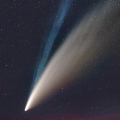
|
It approached to Sun down to 0.29 a.u. on July 3, and it brightened up to 0.6 mag (Alan Hale). Now it is fading. It has faded down to 11.3 mag in September (Sept. 27, Mitsunori Tsumura). Now it is not observable. It will appear in the morning sky at 16 mag.
Date(TT) R.A. (2000) Decl. Delta r Elong. m1 Best Time(A, h)
Nov. 28 16 2.07 -20 22.9 3.785 2.801 3 14.6 2:57 (311,-17)
Dec. 5 16 7.87 -21 1.8 3.866 2.897 9 14.9 2:54 (308,-13)
|
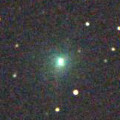
|
It approached to Sun down to 0.34 a.u. on Oct. 20. Then the nucleus was disintegrated. After the perihelion passage, it was observed at 12.5 mag (Oct. 28, Michael Jager). Now only the remnant tail is visible. In the Northern Hemisphere, it stays observable while the comet will be fading rapidly. In the Southern Hemipshere, it will never be observable again.
Date(TT) R.A. (2000) Decl. Delta r Elong. m1 Best Time(A, h)
Nov. 28 14 48.75 7 48.7 1.643 1.027 36 15.2 2:57 (276,-22)
Dec. 5 15 1.37 7 6.2 1.747 1.162 39 15.9 2:54 (275,-19)
|
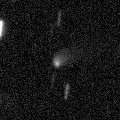
|
Now it is 15.0 mag (Nov. 15, Chris Wyatt). It stays 14-15 mag until 2021. In the Southern Hemisphere, it stays observable in good condition for a long time. In the Northern Hemisphere, it is not observable until June in 2021.
Date(TT) R.A. (2000) Decl. Delta r Elong. m1 Best Time(A, h)
Nov. 28 19 34.46 -62 25.9 4.954 4.432 53 15.2 20:39 ( 34, 34)
Dec. 5 19 49.30 -61 9.5 4.990 4.419 49 15.2 20:47 ( 34, 31)
|

|
Now it is 14.3 mag (Nov. 5, Sandor Szabo). In the Northern Hemisphere, it stays observable for a long time while it is getting fainter slowly. In the Southern Hemisphere, it will never be observable again.
Date(TT) R.A. (2000) Decl. Delta r Elong. m1 Best Time(A, h)
Nov. 28 15 50.08 60 14.4 4.783 4.742 81 15.3 2:57 (216,-48)
Dec. 5 15 57.80 59 55.3 4.809 4.788 82 15.3 2:54 (217,-46)
|

|
Now it is 14.9 mag (Oct. 10, Chris Wyatt). It will brighten up to 13.5 mag in spring in 2021. In the Southern Hemisphere, it stays observable in good condition for a long time, although it becomes unobservable temporarily in December. In the Northern Hemisphere, it is not observable until spring in 2021.
Date(TT) R.A. (2000) Decl. Delta r Elong. m1 Best Time(A, h)
Nov. 28 17 25.29 -45 9.1 4.450 3.606 27 15.3 20:39 ( 40, 9)
Dec. 5 17 28.53 -44 29.0 4.463 3.583 23 15.3 20:47 ( 36, 4)
|
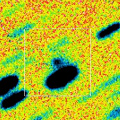
|
Now it is 15.8 mag (Nov. 5, Ken-ichi Kadota). It is observable only until mid December in the Southern Hemisphere, or mid January in the Northern Hemisphere.
Date(TT) R.A. (2000) Decl. Delta r Elong. m1 Best Time(A, h)
Nov. 28 20 4.26 -22 24.8 2.632 2.179 52 15.4 20:39 ( 79, 24)
Dec. 5 20 17.91 -20 59.3 2.680 2.164 48 15.4 20:47 ( 77, 18)
|
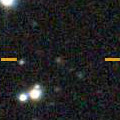
|
Now it is 16.1 mag (Nov. 18, Thomas Lehmann). It will brighten up to 13.5 mag from winter to spring in 2021. In the Northern Hemisphere, it stays observable in excellent condition. In the Southern Hemisphere, it stays extremely low until spring.
Date(TT) R.A. (2000) Decl. Delta r Elong. m1 Best Time(A, h)
Nov. 28 23 25.25 42 15.7 1.346 1.994 116 15.6 20:39 (161, 9)
Dec. 5 23 30.12 40 23.0 1.321 1.925 112 15.4 20:47 (155, 9)
|
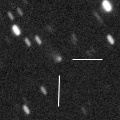
|
Now it is 15.9 mag (Nov. 10, Toshihiko Ikemura, Hirohisa Sato). It will stay at 14 mag for a long time from 2021 to 2022. In the Northern Hemisphere, it stays observable in good condition while brightening gradually, although it becomes unobservable temporarily in December. In the Southern Hemisphere, it is not observable until February.
Date(TT) R.A. (2000) Decl. Delta r Elong. m1 Best Time(A, h)
Nov. 28 17 44.28 8 9.6 6.387 5.625 36 15.5 20:39 ( 84,-22)
Dec. 5 17 47.52 7 23.8 6.399 5.601 33 15.5 20:47 ( 79,-28)
|
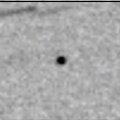
|
It will brighten up to 11.5 mag in spring. However, the condition is very bad in this apparition. It will appear in the morning low sky in March in the Southern Hemisphere, or in June in the Northern Hemisphere.
Date(TT) R.A. (2000) Decl. Delta r Elong. m1 Best Time(A, h)
Nov. 28 16 15.03 -14 46.1 2.814 1.838 6 16.1 2:57 (309,-23)
Dec. 5 16 33.28 -15 47.4 2.770 1.797 7 15.7 2:54 (309,-21)
|
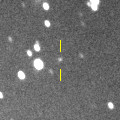
|
Now it is 15.4 mag (Nov. 4, Giuseppe Pappa). It is expected to brighten up to 13 mag in 2022. In 2020, it is observable in excellent condition in the Southern Hemisphere. In the Northern Hemisphere, it is observable from autumn to winter, but it locating extremely low.
Date(TT) R.A. (2000) Decl. Delta r Elong. m1 Best Time(A, h)
Nov. 28 8 33.15 -37 34.4 5.990 6.167 95 15.8 2:57 (286, 76)
Dec. 5 8 32.90 -38 17.3 5.890 6.129 99 15.7 2:54 (294, 81)
|
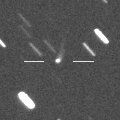
|
Now it is 16.3 mag (Nov. 9, Toshihiko Ikemura, Hirohisa Sato). It will brighten up to 14.5 mag from spring to summer in 2021. In the Southern Hemisphere, it stays observable in excellent condition for a long time. In the Northern Hemisphere, it is observable in good condition in 2020, however, it will be unobservable in 2021.
Date(TT) R.A. (2000) Decl. Delta r Elong. m1 Best Time(A, h)
Nov. 28 21 14.32 -30 59.1 3.307 3.049 66 15.9 20:39 ( 77, 41)
Dec. 5 21 16.21 -31 48.2 3.386 3.015 59 15.9 20:47 ( 73, 35)
|
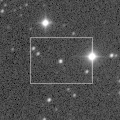
|
Now it is 15.1 mag (Nov. 9, Toshihiko Ikemura, Hirohisa Sato). It stays 15-16 mag until winter. In the Northern Hemisphere, it stays observable in good condition for a long time after this. In the Southern Hemisphere, it will be getting lower after this, and it will be unobservable in January.
Date(TT) R.A. (2000) Decl. Delta r Elong. m1 Best Time(A, h)
Nov. 28 22 23.96 -17 46.2 0.921 1.294 85 15.9 20:39 (105, 49)
Dec. 5 22 38.98 -12 6.3 0.946 1.290 83 16.0 20:47 (108, 42)
|
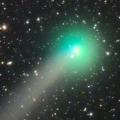
|
It brightened up to 6.0 mag in June (June 13, Marco Goiato). Now it is fading. It has already faded down to 15.7 mag (Nov. 12, Toshihiko Ikemura, Hirohisa Sato). In the Northern Hemisphere, it stays observable for a long time until it fades out. In the Southern Hemisphere, it will never be observable again.
Date(TT) R.A. (2000) Decl. Delta r Elong. m1 Best Time(A, h)
Nov. 28 18 26.19 24 1.7 3.088 2.653 55 16.0 20:39 (105,-22)
Dec. 5 18 39.44 24 25.3 3.193 2.737 54 16.2 20:47 (102,-27)
|
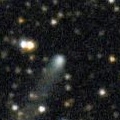
|
Now it is 15.6 mag (Nov. 5, Sandor Szabo). It stays 15-16 mag for a long time until 2021. In the Northern Hemisphere, it stays observable in good condition for a long time, although it becomes very low temporarily from December to January. In the Southern Hemisphere, it will be observable in the extremely low sky only in next spring.
Date(TT) R.A. (2000) Decl. Delta r Elong. m1 Best Time(A, h)
Nov. 28 18 34.98 19 30.7 5.194 4.669 53 16.0 20:39 (102,-18)
Dec. 5 18 38.07 19 51.7 5.253 4.685 50 16.0 20:47 ( 98,-25)
|
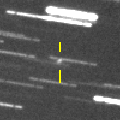
|
First return of a new periodic comet which brightened up to 17 mag in 2013. Now it is 17.2 mag (Nov. 10, Toshihiko Ikemura, Hirohisa Sato). It will brighten up to 16 mag and will be observable in good condition in winter. In the Southern Hemisphere, it locates low until December.
Date(TT) R.A. (2000) Decl. Delta r Elong. m1 Best Time(A, h)
Nov. 28 10 23.61 35 1.8 0.484 1.176 100 16.1 2:57 (215, 9)
Dec. 5 11 2.85 31 36.8 0.471 1.152 98 16.0 2:54 (220, 9)
|
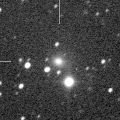
|
It brightened up to 13.5 mag in last winter (Dec. 6, 2019, Chris Wyatt). Now it is fading slowly. Now it is 16.5 mag (Nov. 23, Toshihiko Ikemura, Hirohisa Sato). In the Southern Hemisphere, it stays observable for a long time. It locates somewhat low in the Northern Hemisphere. Taras Prystavski found its fragmentation on Sept. 12.
Date(TT) R.A. (2000) Decl. Delta r Elong. m1 Best Time(A, h)
Nov. 28 1 28.38 -31 40.1 4.242 4.723 113 16.3 20:57 (180, 86)
Dec. 5 1 23.45 -30 16.4 4.362 4.764 108 16.4 20:47 (135, 83)
|
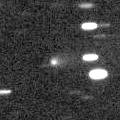
|
Now it is 16.0 mag (Nov. 10, Toshihiko Ikemura, Hirohisa Sato). It stays 16 mag until winter, and observable in good condition. It locates somewhat low in the Southern Hemisphere.
Date(TT) R.A. (2000) Decl. Delta r Elong. m1 Best Time(A, h)
Nov. 28 8 43.13 17 50.0 1.701 2.327 117 16.4 2:57 (203, 34)
Dec. 5 8 43.43 18 11.6 1.661 2.364 124 16.5 2:54 (196, 35)
|
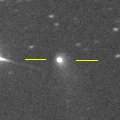
|
It brightened up to 13.8 mag in autumn in 2019 (Sept. 3, 2019, Chris Wyatt). Now it is fading slowly. It has already faded down to 16.5 mag (Nov. 8, Toshihiko Ikemura, Hirohisa Sato). But it is still bright visually as 14.8 mag (Nov. 5, Sandor Szabo).
Date(TT) R.A. (2000) Decl. Delta r Elong. m1 Best Time(A, h)
Nov. 28 23 42.84 2 48.4 6.284 6.704 111 16.4 20:39 (147, 47)
Dec. 5 23 42.34 3 3.9 6.439 6.747 104 16.5 20:47 (137, 42)
|
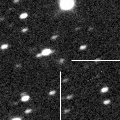
|
Now it is 16.4 mag (Nov. 9, Toshihiko Ikemura, Hirohisa Sato). It is observable at 16.5-17 mag from 2020 to 2021. In the Southern Hemisphere, it is not observable until summer in 2021
Date(TT) R.A. (2000) Decl. Delta r Elong. m1 Best Time(A, h)
Nov. 28 22 3.81 57 39.4 5.632 5.984 106 16.5 20:39 (157,-11)
Dec. 5 22 4.39 55 52.0 5.684 5.979 102 16.5 20:47 (152,-12)
|
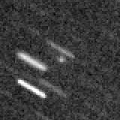
|
Now it is 17.3 mag (Nov. 10, Toshihiko Ikemura, Hirohisa Sato). It will approach to Earth down to 0.46 a.u. in 2021 April, and it is expected to brighten up to 12.5 mag and to be observable in excellent condition.
Date(TT) R.A. (2000) Decl. Delta r Elong. m1 Best Time(A, h)
Nov. 28 22 2.64 -22 6.1 1.709 1.806 79 16.7 20:39 ( 95, 47)
Dec. 5 21 48.71 -21 35.0 1.806 1.724 69 16.6 20:47 ( 88, 37)
|
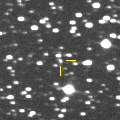
|
Now it is 16.6 mag (Nov. 9, Toshihiko Ikemura, Hirohisa Sato). It stays at 16-17 mag from 2020 to 2021. In the Northern Hemisphere, it stays observable in good condition for a long time. It is not observable in the Southern Hemisphere.
Date(TT) R.A. (2000) Decl. Delta r Elong. m1 Best Time(A, h)
Nov. 28 19 3.55 29 20.7 9.215 8.839 64 16.8 20:39 (114,-17)
Dec. 5 19 5.92 29 23.1 9.261 8.836 61 16.8 20:47 (110,-24)
|
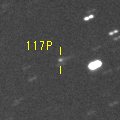
|
Now it is 16.1 mag (Nov. 13, Toshihiko Ikemura, Hirohisa Sato). It will brighten up to 13 mag in 2022. In 2021, it is observable at 15-16 mag in good condition.
Date(TT) R.A. (2000) Decl. Delta r Elong. m1 Best Time(A, h)
Nov. 28 13 0.88 0 27.3 4.511 3.986 52 17.1 2:57 (266, 5)
Dec. 5 13 7.15 -0 8.0 4.408 3.971 57 17.0 2:54 (264, 9)
|
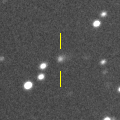
|
It brightened up to 16.1 mag in last winter (Mar. 18, Toshihiko Ikemura, Hirohisa Sato). In 2021, it stays observable at 17 mag in good condition until summer.
Date(TT) R.A. (2000) Decl. Delta r Elong. m1 Best Time(A, h)
Nov. 28 12 49.48 -19 5.7 7.339 6.723 48 17.1 2:57 (281, 18)
Dec. 5 12 53.63 -19 22.7 7.263 6.733 54 17.1 2:54 (279, 22)
|
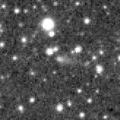
|
First return of a new periodic comet which brightened up to 17.5 mag in 2012. Now it is 17.2 mag (Nov. 13, D. Buczynski). It stays observable at 17 mag in good condition from summer to winter. It locates low in the Southern Hemisphere.
Date(TT) R.A. (2000) Decl. Delta r Elong. m1 Best Time(A, h)
Nov. 28 4 58.99 38 44.0 1.597 2.548 160 17.1 0:32 (180, 16)
Dec. 5 4 51.86 38 49.8 1.609 2.569 163 17.2 23:53 (180, 16)
|
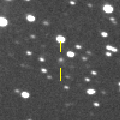
|
Now it is 16.6 mag (Nov. 18, Thomas Lehmann). It will brighten up to 17 mag in December. It is observable in good condition. It locates somewhat low in the Southern Hemisphere.
Date(TT) R.A. (2000) Decl. Delta r Elong. m1 Best Time(A, h)
Nov. 28 2 14.11 36 37.8 1.010 1.926 149 17.2 21:43 (180, 18)
Dec. 5 2 14.90 34 43.1 1.026 1.917 144 17.1 21:17 (180, 20)
|
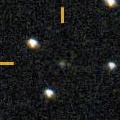
|
Now it is 17.1 mag (Oct. 25, D. Buczynski). It is observable at 17-18 mag for a long time from late 2019 to early 2021. It will fade out before it passes the perihelion.
Date(TT) R.A. (2000) Decl. Delta r Elong. m1 Best Time(A, h)
Nov. 28 5 52.60 17 13.0 3.588 4.512 156 17.3 1:25 (180, 38)
Dec. 5 5 48.78 17 24.7 3.545 4.502 164 17.3 0:54 (180, 38)
|
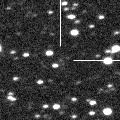
|
Now it is 17.2 mag (Oct. 25, A. Mickleburgh). It stays 15-16 mag for a long time from 2021 spring to 2022 spring. It stays observable for a long time in the Northern Hemisphere. In the Southern Hemipsphere, it is not observable until the end of 2021.
Date(TT) R.A. (2000) Decl. Delta r Elong. m1 Best Time(A, h)
Nov. 28 19 25.99 44 45.8 4.015 3.947 78 17.5 20:39 (131,-21)
Dec. 5 19 27.58 44 13.2 4.023 3.905 76 17.4 20:47 (127,-26)
|

|
First return of a new periodic comet which brightened up to 14-15 mag in 2006. Now it is 17.8 mag (Nov. 23, Toshihiko Ikemura, Hirohisa Sato). It is expected to brighten up to 15-16 mag from February to March, and it will be observable in good condition.
Date(TT) R.A. (2000) Decl. Delta r Elong. m1 Best Time(A, h)
Nov. 28 10 33.49 2 55.2 1.647 1.876 87 17.7 2:57 (240, 32)
Dec. 5 10 48.77 2 22.2 1.560 1.850 90 17.4 2:54 (238, 34)
|
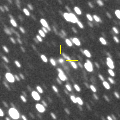
|
Now it is 17.3 mag (Nov. 9, Toshihiko Ikemura, Hirohisa Sato). It will be fading after this, and will be fainter than 18 mag in December.
Date(TT) R.A. (2000) Decl. Delta r Elong. m1 Best Time(A, h)
Nov. 28 21 48.67 -0 51.8 2.113 2.225 83 17.6 20:39 (115, 32)
Dec. 5 22 1.17 -0 55.8 2.204 2.239 79 17.7 20:47 (111, 28)
|

|
Now it is 17.9 mag (Nov. 19, Giuseppe Pappa). It is expected to brighten up to 12 mag in 2022. In the Southern Hemisphere, it stays observable in good condition for a long time. In the Northern Hemisphere, it is not observable until 2022.
Date(TT) R.A. (2000) Decl. Delta r Elong. m1 Best Time(A, h)
Nov. 28 3 39.50 -50 7.6 6.246 6.620 108 17.7 23:07 ( 0, 75)
Dec. 5 3 31.44 -50 22.1 6.240 6.570 105 17.7 22:32 ( 0, 75)
|
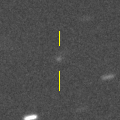
|
Now it is 17.5 mag (Nov. 12, Toshihiko Ikemura, Hirohisa Sato). It is expected to brighten up to 14 mag from spring to summer, and it stays observable in good condition for a long time. In the Southern Hemisphere, it is not observable until late December.
Date(TT) R.A. (2000) Decl. Delta r Elong. m1 Best Time(A, h)
Nov. 28 12 23.99 25 27.9 3.428 3.282 73 17.8 2:57 (241, -3)
Dec. 5 12 33.84 25 17.9 3.290 3.224 77 17.7 2:54 (239, 0)
|
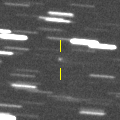
|
Now it is 17.0 mag (Nov. 9, Toshihiko Ikemura, Hirohisa Sato). It stays observable at 17.5-18 mag in good condition until winter.
Date(TT) R.A. (2000) Decl. Delta r Elong. m1 Best Time(A, h)
Nov. 28 7 56.54 18 55.0 1.443 2.197 128 17.7 2:57 (189, 36)
Dec. 5 7 55.69 19 36.9 1.410 2.226 135 17.7 2:54 (182, 35)
|
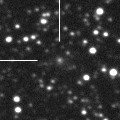
|
It brightened up to 14.6 mag in summer (July 18, Thomas Lehmann). Now it is 17.4 mag (Nov. 8, Toshihiko Ikemura, Hirohisa Sato). It stays observable until December when it becomes fainter than 18 mag.
Date(TT) R.A. (2000) Decl. Delta r Elong. m1 Best Time(A, h)
Nov. 28 21 23.49 -12 42.1 2.379 2.299 73 17.8 20:39 ( 99, 35)
Dec. 5 21 36.37 -12 10.9 2.482 2.325 69 18.0 20:47 ( 96, 30)
|
|
![]()
 29P/Schwassmann-Wachmann 1
29P/Schwassmann-Wachmann 1 11P/Tempel-Swift-LINEAR
11P/Tempel-Swift-LINEAR C/2017 T2 ( PanSTARRS )
C/2017 T2 ( PanSTARRS ) 246P/NEAT
246P/NEAT C/2017 K2 ( PanSTARRS )
C/2017 K2 ( PanSTARRS ) C/2019 L3 ( ATLAS )
C/2019 L3 ( ATLAS ) C/2019 F1 ( ATLAS-Africano )
C/2019 F1 ( ATLAS-Africano ) C/2020 F3 ( NEOWISE )
C/2020 F3 ( NEOWISE ) C/2020 P1 ( NEOWISE )
C/2020 P1 ( NEOWISE ) C/2020 F5 ( MASTER )
C/2020 F5 ( MASTER ) C/2018 N2 ( ASASSN )
C/2018 N2 ( ASASSN ) C/2020 J1 ( SONEAR )
C/2020 J1 ( SONEAR ) 17P/Holmes
17P/Holmes C/2020 N1 ( PanSTARRS )
C/2020 N1 ( PanSTARRS ) C/2018 U1 ( Lemmon )
C/2018 U1 ( Lemmon ) 10P/Tempel 2
10P/Tempel 2 C/2019 T4 ( ATLAS )
C/2019 T4 ( ATLAS ) C/2019 T2 ( Lemmon )
C/2019 T2 ( Lemmon ) 162P/Siding Spring
162P/Siding Spring C/2019 U6 ( Lemmon )
C/2019 U6 ( Lemmon ) C/2019 K7 ( Smith )
C/2019 K7 ( Smith ) P/2020 U1 ( Lemmon )
P/2020 U1 ( Lemmon ) C/2018 F4 ( PanSTARRS )
C/2018 F4 ( PanSTARRS ) 84P/Giclas
84P/Giclas C/2017 B3 ( LINEAR )
C/2017 B3 ( LINEAR ) C/2019 T3 ( ATLAS )
C/2019 T3 ( ATLAS ) C/2020 R4 ( ATLAS )
C/2020 R4 ( ATLAS ) C/2019 O3 ( Palomar )
C/2019 O3 ( Palomar ) 117P/Helin-Roman-Alu 1
117P/Helin-Roman-Alu 1 C/2019 C1 ( ATLAS )
C/2019 C1 ( ATLAS ) 397P/2020 M2 ( Lemmon )
397P/2020 M2 ( Lemmon ) 277P/LINEAR
277P/LINEAR 173P/Mueller 5
173P/Mueller 5 C/2020 M5 ( ATLAS )
C/2020 M5 ( ATLAS ) P/2020 V1 ( LONEOS-Hill )
P/2020 V1 ( LONEOS-Hill ) 257P/Catalina
257P/Catalina C/2020 R7 ( ATLAS )
C/2020 R7 ( ATLAS ) C/2020 T2 ( Palomar )
C/2020 T2 ( Palomar ) 178P/Hug-Bell
178P/Hug-Bell 115P/Maury
115P/Maury![]()











































